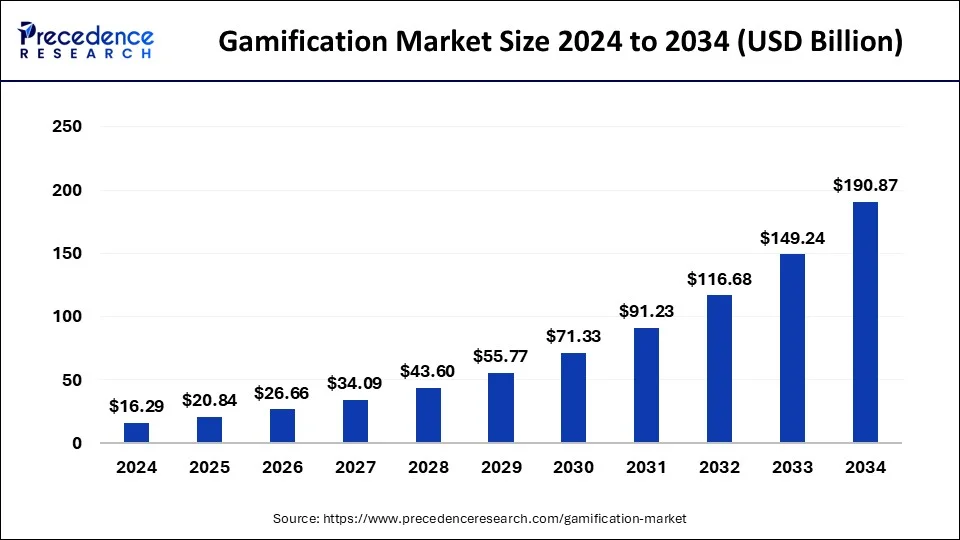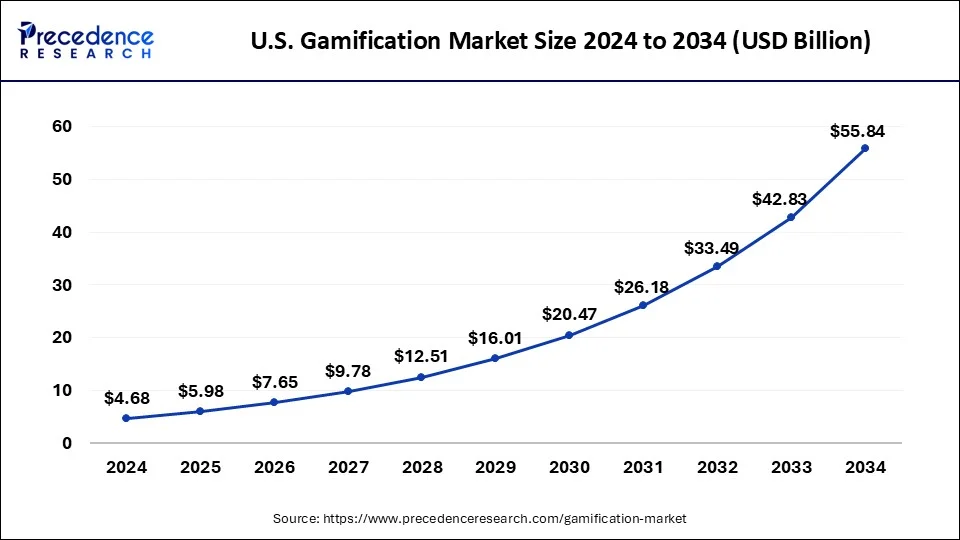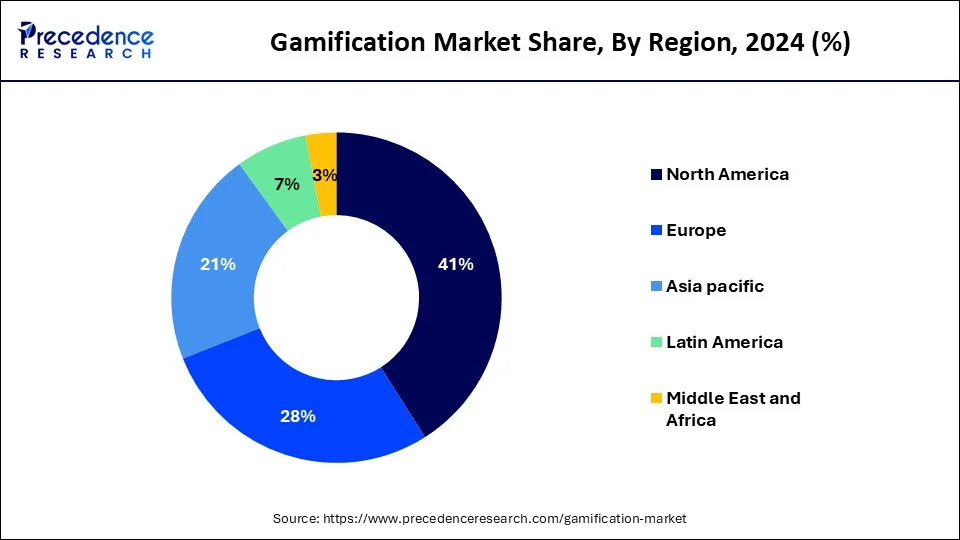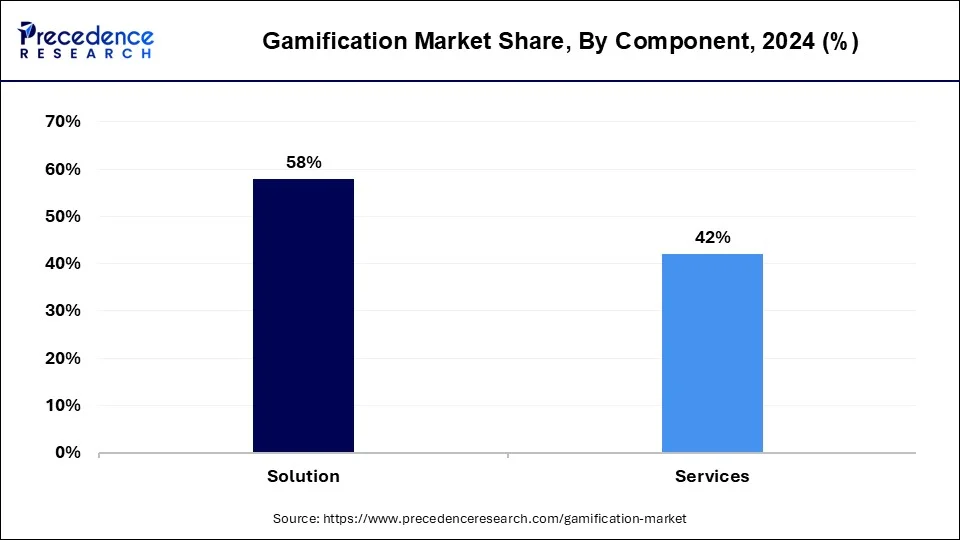Gamification Market Size and Forecast 2024 to 2034
The global gamification market size was estimated at USD 16.29 billion in 2024 and is predicted to increase from USD 20.84 billion in 2025 to approximately USD 190.87 billion by 2034, expanding at a CAGR of 27.90% from 2025 to 2034.

Gamification Market Key Takeaways
- North America gamification market was valued at USD 5.22 billion in 2024.
- The retails industry vertical accounted revenue share of 28.5% in 2024.
- The solution component segment is expected to grow at a CAGR of 21.5% from 2025 to 2034.
U.S. Gamification Market Size and Growth 2025 to 2034
The U.S. gamification market size was evaluated at USD 4.68 billion in 2024 and is predicted to be worth around USD 55.84 billion by 2034, rising at a CAGR of 28.14% from 2024 to 2034.

Why North America region dominated the gamification market?
- North America's revenue share of the gamification market was greatest 41% in 2023.Businesses have extended their usage of the internet to communicate with multiple channel clients and partners. The region's market expansion is likely to be boosted by the region's well-developed communication network and increased demand for customised solutions.
- North America also has the most online players in the world. Emerging organisations in nations such as Canada and the United States are implementing online gaming solutions for improving organisational morale and atmosphere. Because of the existence of customer-centric organisations like as Oracle Corporation, Cisco System, Salesforce, and others, the United States is expected to see the most growth.
- The growing number of mobile phone users and web traffic with in retail and e-commerce industries is also predicted to drive regional market growth. The increase would aid in the adoption of marketing and customer interaction technologies. In compared to other countries, the United States is among the early adopters of solutions. These solutions are used in a company to improve employee management abilities and to foster a positive work culture. As a result of the increased demand, the country has seen an increase in the number of gamification startups.

Why Europe gamification market to witness significant growth?
- During the projection period, Europe is anticipated to witness significant growth. Key players and governments in nations such as the United Kingdom, Germany, France, and others are organising conferences and events to raise awareness of gamification solutions. For example, in December 2019, the Europe Gamification conference was held to help businesses learn about and comprehend the tools and solutions available. Furthermore, nations such as Germany and Spain are projected to acquire traction as retail and healthcare businesses expand.
- Key market participants are focusing on providing advanced solutions to improve employee engagement, raise sales, and deliver a better customer experience, hence raising the demand for software among end users.
Why Asia Pacific hit exponential rate in the gamification market?
- During the projected period, Asia Pacific is predicted to develop at an exponential rate in the market. Asia Pacific is regarded as one of the most promising regions for attracting gamification market participants. China is predicted to have the largest market revenue share.
- The broad market of gamification solutions, as well as extra features such as reward points and membership cards, are increasing client loyalty to the business. This is increasing the demand for the gamification market over the prediction period.
Gamification solutions are increasingly being adopted throughout Latin America, the Middle East, and Africa. The rising number of regional and local solution providers is driving market expansion in these regions. The amount of new and indigenous software companies is increasing throughout Latin America. In addition, the government is promoting small and medium-sized businesses and innovation in the area. Brazil's growing interest in E-learning and game-based education is increasing the sector.
Market Overview
During the global crisis, organisations' initiatives for training employees using gamification software will support healthy market growth. Furthermore, the increased emphasis on E-learning with learning and training courses for working professionals during the COVID-19 epidemic will encourage healthy gamification adoption.
The implementation of game-design features and gaming ideas in non-game environments is known as gamification. It may also be considered as a set of actions and methods used to address issues by utilising or applying game element characteristics. Furthermore, for thousands of years, games and game-like aspects have been utilised to educate, excite, and engage with people. Points, leader boards and badges are examples of traditional game components. Gamification incorporates game elements into many contexts such as organisations, workspaces, online communities, consumers, workers, vendors, and partners in order to inspire as well as encourage them. This also contributes to the creation of a community entertainment, interaction, and team building atmosphere. The programme enables firms to create interactive and task-based activities that inspire employees to achieve their objectives. Game-based solutions may also be used for training and recruiting. Furthermore, these solutions provide the client with additional knowledge about the product and its brand, which aids in the improvement of customer relationships. Service Corporation International, for example, had an 88 percent increase in closing deals after implementing the gamification application.
Employee rewards and recognition for success, as well as delivering enticing offers to clients and consumers, drive the expansion of the gamification business. Furthermore, increased ROI from gamification has a favourable influence on the growth of the gamification sector. However, the complexity of designing gamification applications, as well as the short lifetime of gamification, are impeding market growth. On the contrary, usage of AI for analyzing and displaying customised results is likely to provide lucrative chances for market advancement throughout the forecast period. The COVID-19 epidemic had a beneficial influence on the gamification sector since it increased market for mobile gaming applications and software to the whole new level. Furthermore, the pandemic has generated an ideal need for gamification, particularly because it has offered a chance to boost participation under lockdown.
Market Scope
| Report Coverage | Details |
| Market Size in 2025 | USD 20.84 Billion |
| Market Size by 2034 | USD 190.87 Billion |
| Growth Rate from 2025 to 2034 | CAGR of 27.90% |
| Dominated Region | North America |
| Base Year | 2024 |
| Forecast Period | 2025 to 2034 |
| Segments Covered | Component, Deployment Model, Enterprise Size, Application, Industry Vertical, Geography |
| Regions Covered | North America, Europe, Asia-Pacific, Latin America and Middle East & Africa |
Market Dynamics
Drivers
Adoption of gamification solutions based on artificial intelligence to incentivise market growth.
- To get deep insights on their staff, many enterprises are implementing AI-based technologies and cutting-edge technology. AI-based gamification models deliver correct answers by removing ambiguity in employee motives and assisting employees in meeting objectives more effectively. Key market participants are focusing on developing of AI-based solutions. Companies are implementing AI-based gamification systems in business units such as marketing, HR, and sales to increase the relationship between employee labour and the company's goals.
Companies' increasing investment in augmented reality (AR), virtual reality (VR), and mixed reality technologies will result in strong market growth throughout the forecast period. Amazon.com, Inc. and Walmart, for example, are employing AR, VR, and mixed reality technology to change the customer shopping experience. Similarly, various organisations are constantly spending in augmented reality simulation for learning and training reasons, which will allow for rapid market development. Walmart, for example, has established a collaboration with Strivr Labs, Inc. to provide VR training to its staff. The training will be delivered to the company's primary 200 centres around the United States to demonstrate valuable customer service support to staff.
Component Insights
The solution category has the greatest gamification market share based on component because it includes multiple functions such as maintenance, space planning, wealth management, move management, and real-estate. It decreases the number of complications and costs involved with space management. Furthermore, it increases asset longevity and lowers energy costs. This has a favourable influence on the gamification market. Learners like gamification because it blends "entertainment" with serious learning. Organizations realise the benefits of employing it for sticky learning, on-the-job application, practise and nudges to mastery, and behavioural change. Gamification solutions are widely used in the corporate world for a variety of reasons, including the fact that they provide a more engaging learning experience because the learner is engaged in a variety of activities and challenges, as opposed to the passive learning approach provided by a more traditional eLearning approach.

However, the services category is predicted to develop at the fastest rate over the projection period, owing to enterprises' adoption of the IT as a service model. It is an IT service model for companies that manages organisations' strategic business requirements in addition to their regular operations, and it is predicted to develop at a much faster rate throughout the projection period.
Application Insights
In 2024, the product development category held a significant share of the revenue in the gamification market. Gamification is described as a deliberate attempt to assist infrastructure and applications in providing experiences similar to those experienced when playing video games. This is intended to further motivate and inspire product or service consumers. Gamification is typically addressed when developers and designers incorporate game-like aspects into non-game goods and services.
Industry Verticals Insights
According to verticals, the telecom segment would develop at the fastest pace throughout the predicted period. Telecom firms also face intense competition from other service suppliers, making the implementation of a customer-centric approach critical. Companies' major objective is to increase the subscriber base who have consistent experiences throughout all channels, which can only be accomplished through customer-focused solutions. Although these organisations have minimal control over the content and products, the client will make them responsible for availability and quality. Companies may use the gamification solution to learn about customers' satisfaction and engage them in new offerings and rewards.
Deployment Insights
The Gamification market is bifurcated into two-fold segments based on the type of deployment i.e. on-premise and cloud. In 2023, the cloud sector will have a considerable share of the revenue in the gamification industry. It is because SMEs are increasingly seeking safe and trustworthy solutions. Firms are increasingly likely to use cloud-based gamification solutions as technology advances. Several major organisations, including retailers, e-commerce, Banking, educational, and others, are integrating cloud-based infrastructure to give collaborative experiences to customers. Users benefit from advantages including such simple installation, servicing, software updates, and more when using cloud-based solutions. Key aspects such as low installation costs are expected to drive market growth for cloud-based solutions over the forecast period.
Gamification Market Companies
- Microsoft Corporation
- MPS Interactive Systems Limited
- Ambition
- Aon plc.
- Axonify Inc.
- BI WORLDWIDE (Bunchball Inc.)
- Callidus Software Inc. (SAP SE)
- Cognizant
- G-Cube
- IActionable
Key Market Developments
- Microsoft acquired Activision Blizzard, an American video game holding firm, in January 2022. Through this acquisition, the business planned to accelerate the expansion of Microsoft's gaming sector across PC, mobile, console, and cloud platforms, as well as to provide building blocks for the metaverse.
- December 2021: SAP announced a collaboration with Attensi, the worldwide leader in 3D gamified simulation training. The firms collaborated to provide development and learning through the use of SAP SuccessFactors Solutions. Furthermore, Attensi would deliver a fresh learning experience by including, among other things, game automation and a competitive component.
- November 2021: Ambition announced a partnershi
Segments covered in the report
By Component
- Solution
- Service
By Deployment Model
- On Premise
- Cloud
By Enterprise Size
- Large Enterprises
- SMEs
By Application
- Sales & Marketing
- Product Development
- Human Resource
- Support
- Others
By Industry Vertical
- Retail
- Education
- IT and telecom
- BFSI
- Manufacturing
- Media and Entertainment
- Other
By Geography
- North America
- U.S.
- Canada
- Europe
- U.K.
- Germany
- France
- Asia-Pacific
- China
- India
- Japan
- South Korea
- Malaysia
- Philippines
- Latin America
- Brazil
- Rest of Latin America
- Middle East & Africa (MEA)